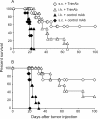Three agonist antibodies in combination with high-dose IL-2 eradicate orthotopic kidney cancer in mice
- PMID: 20426873
- PMCID: PMC2873376
- DOI: 10.1186/1479-5876-8-42
Three agonist antibodies in combination with high-dose IL-2 eradicate orthotopic kidney cancer in mice
Abstract
Background: Combination immunotherapies can be effective against subcutaneous tumors in mice but the effect against orthotopic malignant disease is less well characterized. In particular, a combination of three agonist antibodies, termed Tri-mAb, consisting of anti-DR5, anti-CD40 and anti-CD137 has previously been demonstrated to eradicate a large proportion of subcutaneous renal cell carcinoma (Renca) tumors (75% long-term survival), but the effect against orthotopic disease is not known.
Purpose: To determine the relative response of orthotopic tumors, we inoculated Renca into the kidney followed by treatment with Tri-mAb.
Results: We found that orthotopic tumors responded much less to treatment (approximately 13% survival), but a significant improvement in survival was achieved through the addition of IL-2 to the treatment regimen (55% survival). All three agonist antibodies and high dose IL-2, 100,000 IU for up to six doses, were required. CD8+ T cells were also required for optimal anti-tumor responses. Coadministration of IL-2 led to enhanced T cell activity as demonstrated by an increased frequency of IFN-gamma-producing T cells in tumor-draining lymph nodes, which may have contributed to the observed improvement of therapy against kidney tumors.
Implications: Responses of subcutaneous tumors to immunotherapy do not necessarily reflect how orthotopic tumors respond. The use of combination immunotherapy stimulating multiple facets of immunity and including cytokine support for T cells can induce effective anti-tumor responses against orthotopic and metastatic tumors.
Figures







References
-
- Takahashi C, Mittler RS, Vella AT. Cutting edge: 4-1BB is a bona fide CD8 T cell survival signal. J Immunol. 1999;162:5037–5040. - PubMed
Publication types
MeSH terms
Substances
LinkOut - more resources
Full Text Sources
Other Literature Sources
Medical
Research Materials

